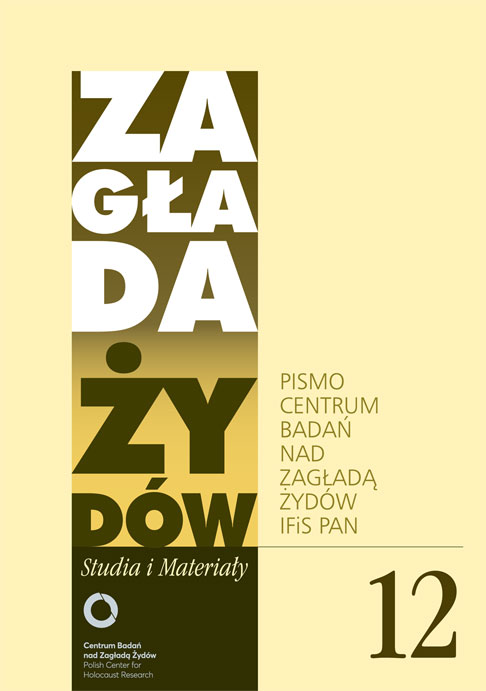Społeczeństwo holenderskie i los Żydów: skomplikowana historia
Zagłada Żydów. Studia i Materiały, Nr 12 (2016), Strony: 425-434
Data zgłoszenia: 2020-10-20Data publikacji: 2016-11-30
 https://doi.org/10.32927/ZZSiM.426
https://doi.org/10.32927/ZZSiM.426
Abstrakt
The percentage of victimization of Dutch Jewry during the Shoah is the highest of Western, Central and Southern Europe (except, perhaps of Greece), and close to the Polish one: 75%, more than 104.000 souls. The question of disproportion between the apparent favorable status of the Jews in society – they had acquired emancipation in 1796 - and the disastrous outcome of the Nazi occupation as compared to other countries in general and Western European in particular has haunted Dutch historiography of the Shoah. Who should be blamed for that outcome: the perpetrators, i.e. the Germans, the bystanders, i.e. the Dutch or the victims, i.e. the Dutch Jews? The article first surveys the answers given to this question since the beginnings of Dutch Holocaust historiography in the immediate post-war period until the debates of today and the factors that influenced the shaping of some basic perceptions on “Dutch society and the Jews”. It then proceeds to detailing several facts from the Holocaust period that are essential for an evaluation of gentile attitudes. The article concludes with the observation that – in spite of ongoing debates – the overall picture which has accumulated after decades of research will not essentially being altered. Although the Holocaust was initiated, planned and carried out from Berlin, and although a considerable number of Dutchmen helped and hid Jews and the majority definitely despised the Germans, considerable parts of Dutch society contributed to the disastrous outcome of the Jewish lot in the Netherlands – through a high amount of servility towards the German authorities, through indifference when Jewish fellow-citizens were persecuted, through economically benefiting from the persecution and from the disappearance of Jewish neighbors, and through actual collaboration (stemming from a variety of reasons). Consequently, the picture of the Holocaust in the Netherlands is multi-dimensional, but altogether puzzling and not favorable.
Słowa kluczowe
społeczeństwo holenderskie wobec Żydów , literatura o Zagładzie w Holandii
Licencja
Prawa autorskie (c) 2016 Autor&"Zagłada Żydów. Studia i Materiały"

Utwór dostępny jest na licencji Creative Commons Uznanie autorstwa 4.0 Międzynarodowe.
https://creativecommons.org/licenses/by/4.0
Czasopismo publikowane jest w standardzie Diamond Open Access na licencji CC-BY-4.0 Deed - Uznanie autorstwa 4.0 Międzynarodowa - Creative Commons
Inne teksty tego samego autora
- Avner Shalev, Dan Michman, David Silberklang, Ścisła pamięć o Zagładzie w Muzeum Historii Holokaustu w Yad Vashem. Odpowiedź na artykuł Amosa Goldberga , Zagłada Żydów. Studia i Materiały: Nr 7 (2011)
Podobne artykuły
- Jan Grabowski, Stefan Klemp, Freispruch für das „Mord-Bataillon”. Die NS-Ordnungspolizei und die Nachkriegsjustiz , Zagłada Żydów. Studia i Materiały: Nr 10 (2014)
- Markus Nesselrodt, Kto, kiedy i dlaczego? Ucieczki polskich Żydów przed Niemcami do Związku Radzieckiego jesienią 1939 i latem 1941 r. w perspektywie porównawczej , Zagłada Żydów. Studia i Materiały: Nr 18 (2022)
- Agnieszka Haska, „Choć klimat jest dobry…” Polscy Żydzi internowani na Jamajce w latach 1942–1945 , Zagłada Żydów. Studia i Materiały: Nr 17 (2021)
- Agnieszka Haska, Aleksandra Bańkowska, Powojenni lokatorzy budynku przy ul. Tłomackie 5 , Zagłada Żydów. Studia i Materiały: Nr 8 (2012)
- Agnieszka Żółkiewska, Monika Polit, „Moja żydowska dusza nie obawia się dnia sądu”. Mordechaj Chaim Rumkowski. Prawda i zmyślenie , Zagłada Żydów. Studia i Materiały: Nr 9 (2013)
- Jan Grabowski, Hunting down Emanuel Ringelblum. The Participation of the Polish Kriminalpolizei in the ‘Final Solution of the Jewish Question , Zagłada Żydów. Studia i Materiały: Nr Holocaust Studies and Materials (2017)
- Jan Grabowski, Waitman Wade Beorn, Marching into Darkness. The Wehrmacht and the Holocaust in Belarus , Zagłada Żydów. Studia i Materiały: Nr 10 (2014)
- Havi Dreifuss, Komenda Żydowskiej Organizacji Bojowej podczas powstania w getcie warszawskim – nowe ujęcie , Zagłada Żydów. Studia i Materiały: Nr 19 (2023)
- Dagmara Swałtek, Dla płaszcza, walizki i jabłka. Zbrodnie na Żydach ukrywających się we wsiach Falkowa, Wieniec i Janowice w świetle powojennych dokumentów procesowych , Zagłada Żydów. Studia i Materiały: Nr 4 (2008)
- Katrin Stoll, Rozkład jazdy tylko w jedną stronę. Przesłuchania byłych urzędników Reichsbahn na temat deportacji Żydów z Prużan do Auschwitz w 1943 r. , Zagłada Żydów. Studia i Materiały: Nr 12 (2016)
<< < 7 8 9 10 11 12 13 14 15 16 17 18 19 20 21 22 23 24 25 26 27 28 29 30 31 32 33 34 35 36 37 38 39 40 41 42 43 44 45 46 47 48 49 50 51 52 53 54 55 56 > >>
Możesz również Rozpocznij zaawansowane wyszukiwanie podobieństw dla tego artykułu.
 English
English
 Język Polski
Język Polski



 https://orcid.org/0000-0001-7496-496X
https://orcid.org/0000-0001-7496-496X

